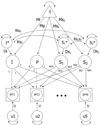The role of occupational complexity in trajectories of cognitive aging before and after retirement
- PMID: 19739912
- PMCID: PMC2742987
- DOI: 10.1037/a0015511
The role of occupational complexity in trajectories of cognitive aging before and after retirement
Abstract
We examined the association between complexity of the main lifetime occupation and changes in cognitive ability in later life. Data on complexity of work with data, people, and things and on 4 cognitive factors (verbal, spatial, memory, and speed) were available from 462 individuals in the longitudinal Swedish Adoption/Twin Study of Aging. Mean age at the first measurement wave was 64.3 years (SD = 7.2), and 65% of the sample had participated in at least three waves of data collection. Occupational complexity with people and data were both correlated with cognitive performance. Individuals with more complex work demonstrated higher mean performance on the verbal, spatial, and speed factors. Latent growth curve analyses indicated that, after correcting for education, only complexity with people was associated with differences in cognitive performance and rate of cognitive change. Continued engagement as a result of occupational complexity with people helped to facilitate verbal function before retirement, whereas a previous high level of complexity of work with people was associated with faster decline after retirement on the spatial factor.
(c) 2009 APA, all rights reserved.
Figures





Similar articles
-
Effects of Preretirement Work Complexity and Postretirement Leisure Activity on Cognitive Aging.J Gerontol B Psychol Sci Soc Sci. 2016 Sep;71(5):849-56. doi: 10.1093/geronb/gbv026. Epub 2015 May 14. J Gerontol B Psychol Sci Soc Sci. 2016. PMID: 25975289 Free PMC article.
-
Latent growth curve analyses of accelerating decline in cognitive abilities in late adulthood.Dev Psychol. 2003 May;39(3):535-50. doi: 10.1037/0012-1649.39.3.535. Dev Psychol. 2003. PMID: 12760521
-
Occupational complexity and lifetime cognitive abilities.Neurology. 2014 Dec 9;83(24):2285-91. doi: 10.1212/WNL.0000000000001075. Epub 2014 Nov 19. Neurology. 2014. PMID: 25411439 Free PMC article.
-
Is Occupational Complexity Associated with Cognitive Performance or Decline? Results from the Australian Longitudinal Study of Ageing.Gerontology. 2017;63(6):550-559. doi: 10.1159/000475559. Epub 2017 May 17. Gerontology. 2017. PMID: 28511173
-
Age changes in processing speed as a leading indicator of cognitive aging.Psychol Aging. 2007 Sep;22(3):558-68. doi: 10.1037/0882-7974.22.3.558. Psychol Aging. 2007. PMID: 17874954
Cited by
-
Education and Cognitive Functioning Across the Life Span.Psychol Sci Public Interest. 2020 Aug;21(1):6-41. doi: 10.1177/1529100620920576. Psychol Sci Public Interest. 2020. PMID: 32772803 Free PMC article. Review.
-
Workplace Exposures and Cognitive Function During Adulthood: Evidence From National Survey of Midlife Development and the O*NET.J Occup Environ Med. 2016 Jun;58(6):535-41. doi: 10.1097/JOM.0000000000000727. J Occup Environ Med. 2016. PMID: 27281637 Free PMC article.
-
The relationship between cognitive engagement and better memory in midlife.Alzheimers Dement (Amst). 2022 Feb 9;14(1):e12278. doi: 10.1002/dad2.12278. eCollection 2022. Alzheimers Dement (Amst). 2022. PMID: 35155733 Free PMC article.
-
Alternative Retirement Paths and Cognitive Performance: Exploring the Role of Preretirement Job Complexity.Gerontologist. 2020 Apr 2;60(3):460-471. doi: 10.1093/geront/gnz079. Gerontologist. 2020. PMID: 31289823 Free PMC article.
-
The Association Between Cognitive Reserve and Cognitive Trajectories Among Older Adults.Innov Aging. 2024 Feb 14;8(2):igae014. doi: 10.1093/geroni/igae014. eCollection 2024. Innov Aging. 2024. PMID: 38529198 Free PMC article.
References
-
- Andel R, Crowe M, Pedersen NL, Mortimer JA, Crimmins E, Johansson B, Gatz M. Complexity of work and risk of Alzheimer’s disease: a population-based study of Swedish twins. Journal of Gerontology: Psychological Sciences. 2005;60B:P251–P258. - PubMed
-
- Andel R, Kåreholt I, Parker M, Thorslund M, Gatz M. Complexity of main lifetime occupation and cognition in advanced old age. Journal of Aging and Health. 2007;19:397–415. - PubMed
-
- Bosma H, van Boxtel MPJ, Ponds RWHM, Houx PJ. Mental work demands protect against cognitive impairment: MAAS prospective cohort study. Experimental Aging Research. 2003;29:33–45. - PubMed
-
- Bryk AS, Raudenbush SW. Hierarchical linear models. London: Sage Publications; 1992.
-
- Churchill JD, Galvez R, Colcombe S, Swain RA, Kramer AF, Greenough WT. Exercise, experience and the aging brain. Neurobiology of Aging. 2002;23:941–955. - PubMed

